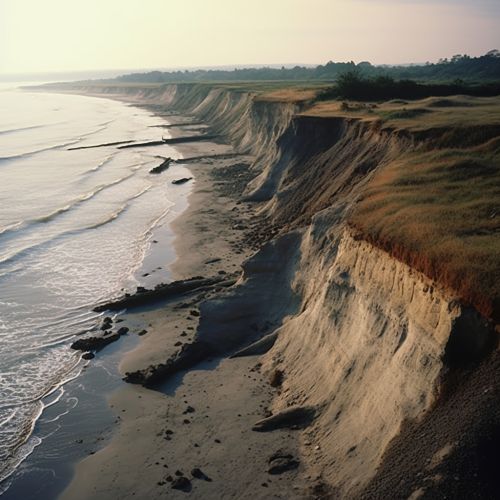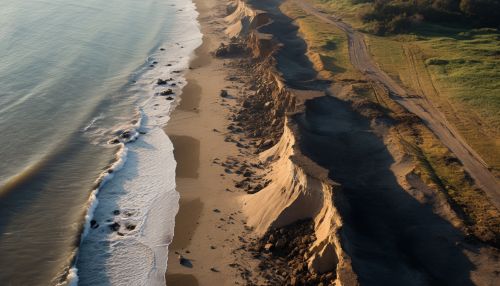Coastal Erosion
Introduction
Coastal erosion refers to the process by which the land along the coastline is worn away by the action of sea waves, currents, or high winds. This natural phenomenon is a significant aspect of coastal geomorphology, shaping the physical features of coastlines worldwide.


Causes of Coastal Erosion
Coastal erosion is primarily caused by the action of wave and current energy. The energy generated by waves and currents can erode the coastline in several ways, including hydraulic action, abrasion, attrition, and solution.
Hydraulic Action
Hydraulic action refers to the process by which waves compress pockets of air in cracks in the coastline. This compression can cause the rock to fracture and break apart, leading to erosion.
Abrasion
Abrasion, also known as corrasion, is the process by which waves carrying sediment wear down the coastline. The sediment acts like sandpaper, grinding away at the rock and gradually eroding it.
Attrition
Attrition is the process by which rocks and pebbles carried by waves collide with each other and break down into smaller, smoother, and rounder particles. This process contributes to the erosion of the coastline by increasing the amount of sediment available for abrasion.
Solution
Solution, also known as corrosion, is the process by which certain types of rock, such as limestone and chalk, are dissolved by the acidity in seawater. This process can lead to significant erosion in areas where these types of rock are prevalent.
Effects of Coastal Erosion
Coastal erosion can have significant effects on both the natural environment and human activities. These effects can be both positive and negative, and they can vary greatly depending on the specific circumstances of the area affected.
Natural Environment
In the natural environment, coastal erosion can lead to the loss of habitats for a variety of plant and animal species. This can have significant impacts on biodiversity, particularly in areas where the coastline provides unique habitats that cannot be found elsewhere.
On the other hand, the process of erosion can also create new habitats. For example, the sediment eroded from the coastline can be deposited elsewhere, creating new beaches or sand dunes that can be colonized by different species.
Human Activities
In terms of human activities, coastal erosion can lead to the loss of land that is used for housing, agriculture, or other purposes. This can have significant economic impacts, particularly in areas where land is scarce or highly valued.
However, coastal erosion can also provide opportunities for human activities. For example, the process of erosion can create new landforms that are attractive for tourism, such as cliffs or sea stacks.
Management of Coastal Erosion
The management of coastal erosion involves a range of strategies that are designed to mitigate the effects of erosion. These strategies can be broadly categorized into hard engineering techniques and soft engineering techniques.
Hard Engineering Techniques
Hard engineering techniques involve the construction of physical structures to protect the coastline from erosion. These techniques include the use of sea walls, groynes, riprap, and breakwaters.
Sea walls are structures that are built parallel to the coastline to prevent erosion by reflecting wave energy. Groynes are structures that are built perpendicular to the coastline to prevent the movement of sediment along the coast. Riprap involves the placement of large rocks or concrete blocks along the coastline to absorb wave energy and prevent erosion. Breakwaters are structures that are built offshore to reduce wave energy and protect the coastline.
Soft Engineering Techniques
Soft engineering techniques involve the use of natural processes to protect the coastline from erosion. These techniques include beach nourishment, dune stabilization, and the creation of buffer zones.
Beach nourishment involves the addition of sediment to the beach to replace the sediment that has been eroded. Dune stabilization involves the planting of vegetation to stabilize sand dunes and prevent erosion. Buffer zones involve the creation of areas where development is restricted in order to protect the coastline from erosion.
